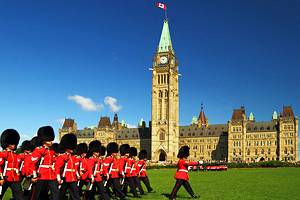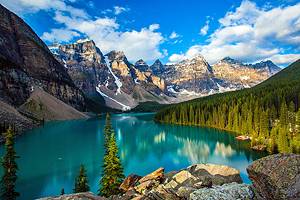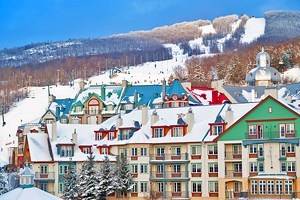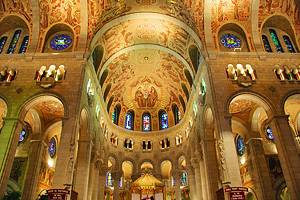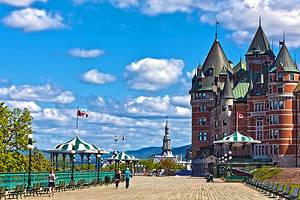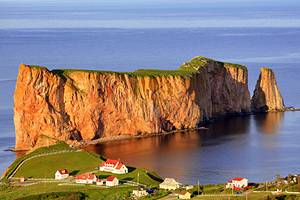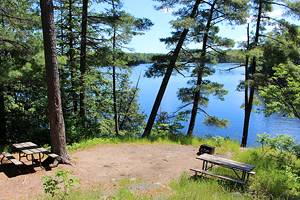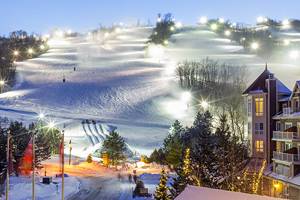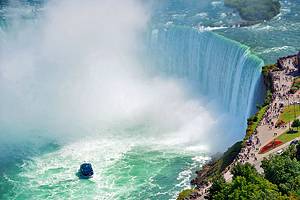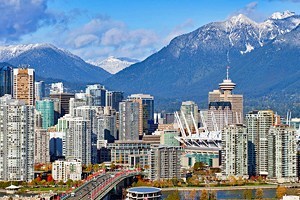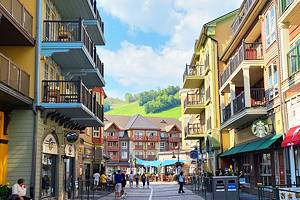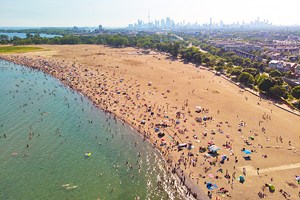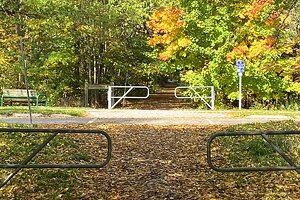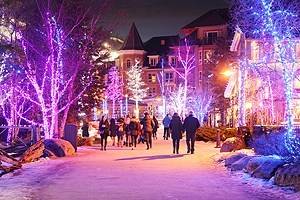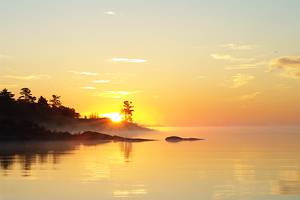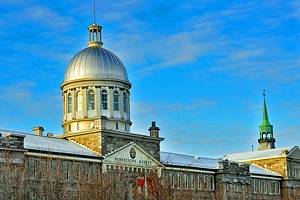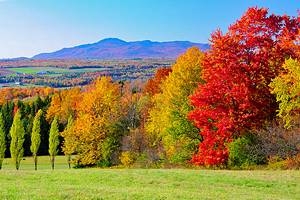Tourist Attractions in Québec
A vast province that makes up about one-sixth of Canada, Québec covers diverse landscapes – from historic cities to isolated Arctic tundra. The region reaches almost to the Arctic Circle in the north, borders the American states of Vermont and New York in the south, and Ontario and Hudson Bay in the west. The St. Lawrence River, almost 1,200 kilometers long, runs through the most populated regions of the province.
While most visitors head for the two main cities, Montréal and Québec City, there are many things to do throughout the province in both summer and winter. Historical sites, cultural institutions, festivals, small towns, and beautiful parks and natural areas are just some of the highlights. Find the best places to visit in the province with our list of the top attractions in Québec.
Place Royale
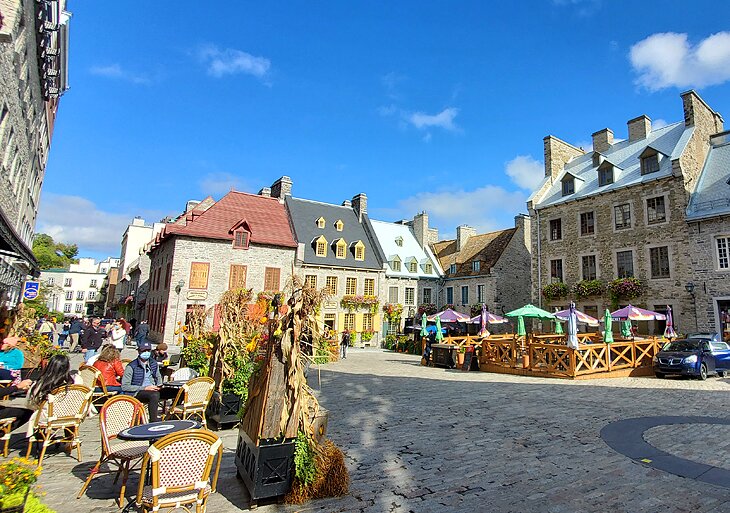
Place Royale is the birthplace of Québec City, where Samuel de Champlain established habitation in 1608, which was the first permanent French settlement in North America.
This area has an outstanding collection of 17th- and 18th-century buildings that are a small sampling of Old Québec. The pretty stone church Notre-Dame des Victoires, dating to 1688, faces the square and is frequently seen in postcards and photos of the city.
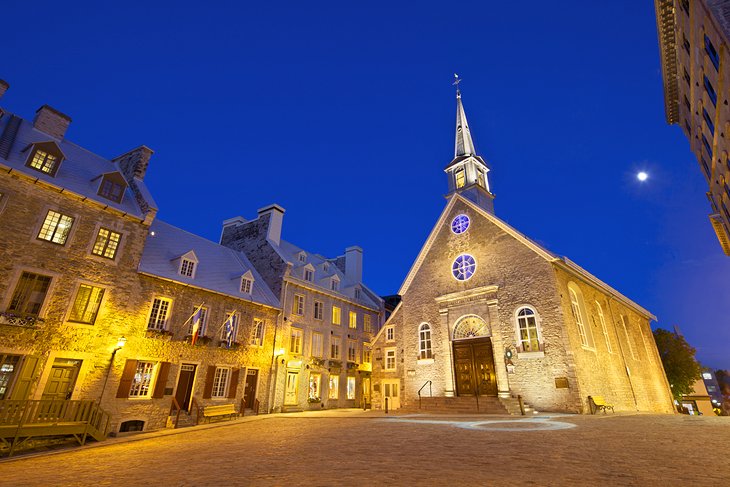
You'll find plenty of Old Québec City sightseeing within blocks, especially in the delightful Quartier Petit-Champlain, where historic buildings line narrow pedestrian-only streets. Wander through artisan boutiques, enjoy a meal at one of the fantastic restaurants, and see a historic-themed trompe-l'oeil mural.
Read More: Attractions & Places to Visit in Québec City
Old Montréal (Vieux-Montreal)
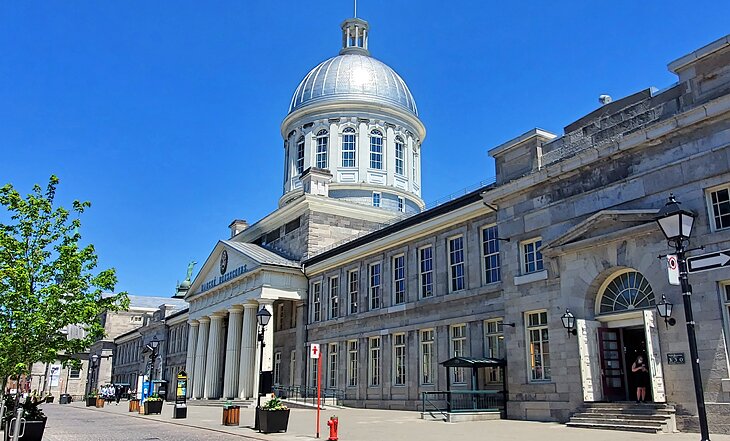
Best explored on foot, Old Montréal is a concentration of 17th-, 18th-, and 19th-century buildings at the edge of the city's Old Port. Many of the top Montréal tourist attractions are within this historic section of the city, including the neo-Gothic Notre-Dame Basilica and the pedestrian-friendly square at Place Jacques-Cartier.
The Old Port area is home to many things to do with your family, including the Montréal Science Center and the Natrel Skating Rink. Couples and families alike will love La Grande Roue de Montréal (Observation Wheel). This newer addition to the river's edge provides spectacular views over Old Montréal, downtown, and beyond from within enclosed gondolas.
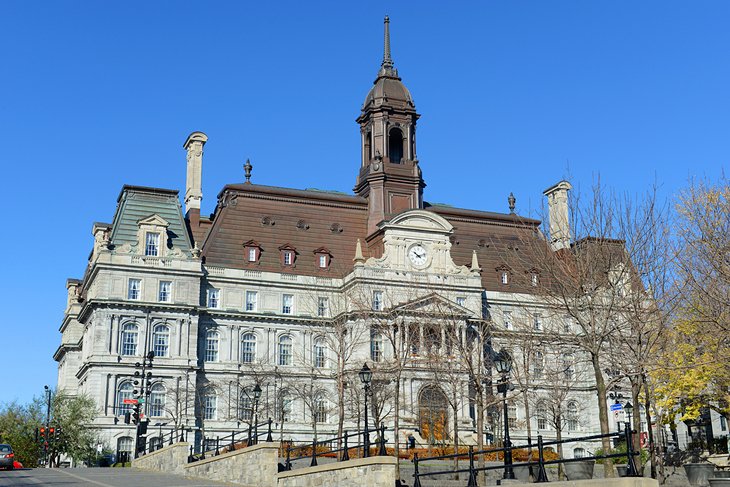
Read More: Tourist Attractions in Old Montréal
Le Château Frontenac

Overlooking Québec City, the grandiose Château Frontenac is the most iconic building in the provincial capital, visible from miles away. Canadian Pacific Railway constructed the hotel in 1894, and it still welcomes guests from around the world in one of the most romantic settings you can find.
The hillside vantage was once the location of Fort St.-Louis, but today, the wide boardwalk of Terrasse Dufferin provides scenic views south to Levis and the St. Lawrence River. Both hotel guests and tourists can see the ruins of the fort that lie beneath the Promenade des Gouverneurs, a main road which leads south toward the Plains of Abraham and the Citadel.
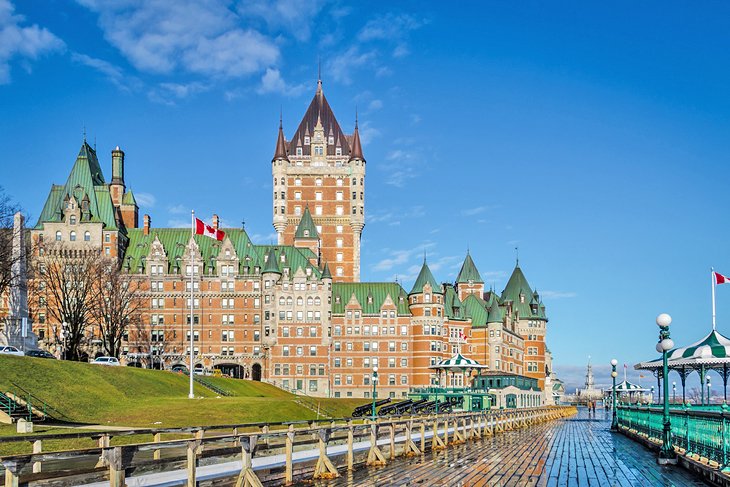
Address: 1 Rue des Carrières, Québec City, Québec
Musee de la Civilisation (Museum of Civilization)
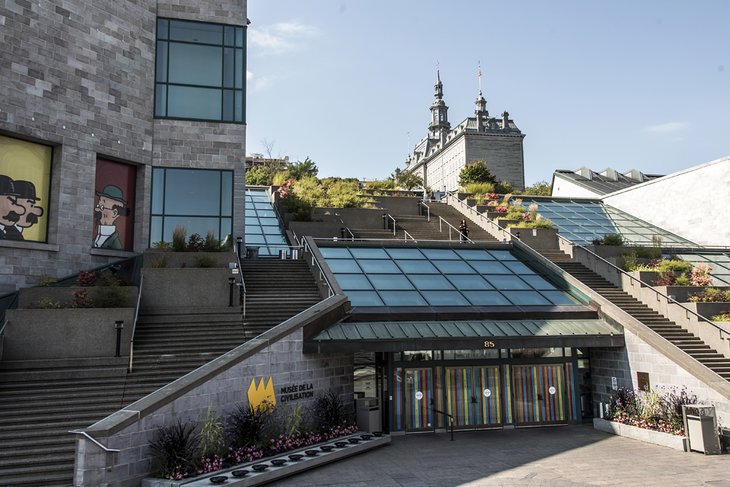
Sitting on the banks of the Saint Lawrence River in Quebec City's Vieux Port (Old Port) area, the Museum of Civilization houses an astounding collection of artifacts and exhibits dedicated to human civilization around the world.
Permanent collections also include exhibits focused on regional history, including the history of the first encounters between European and native peoples, the development of the territories, and the people of Québec.
Other permanent exhibits explore important landmark buildings, the history of the sugar beet industry, the history of horse-drawn carriages, and even a "digital laboratory" where visitors can do their own research. Temporary exhibits cover a variety of anthropological topics, from aboriginal societies to explorations of how the modern digital age has affected human civilization.
Many of the exhibits include interactive elements, both for younger visitors and adults, and there are special kids' activities available as well. Guided tours are available.
There is also an outpost of the Museum of Civilization at Place Royale, and tourists can learn more about the history of French-Canadians at the Musée de l'Amérique Francophone (Museum of French America), which specializes in looking at the history and present state of French immigrants in the Americas; it is located in the city's Upper Town at the historic Séminaire de Québec.
Address: 85, rue Dalhousie, Quebec City, Québec
Official site: www.mcq.org/en
Chutes Montmorency
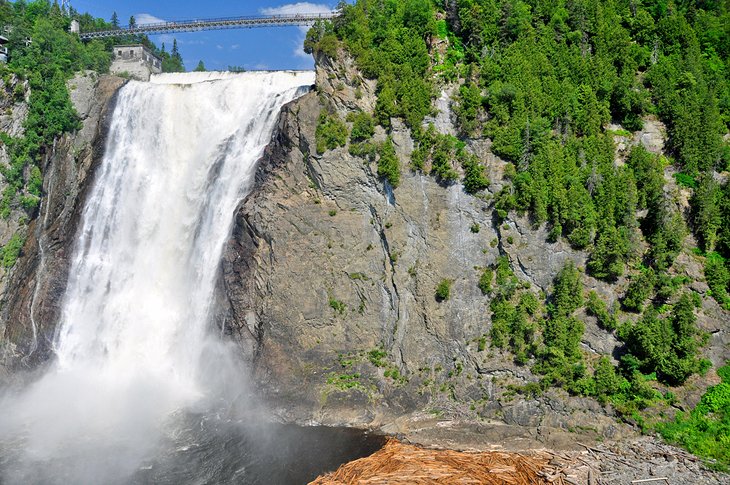
Just northeast of Québec City, the wide sweeping waterfall of Chutes Montmorency cascades down an 84-meter escarpment. The falls are higher than Niagara Falls, and a narrow pedestrian suspension bridge crosses the top of the falls, enabling you to watch the water rush over the edge right beneath your feet.
There is also a cable car, which travels to the top of the falls and provides great views of the surrounding landscape, and the Montmorency Manor houses an interpretive center and a restaurant. Visitors can also enjoy views of the falls from the numerous trails, stairways, and viewing platforms, and there are several picnic areas. More adventurous visitors can also try out the 300-meter zipline across the falls or go rock climbing on nearby cliffs.
Address: 5300 boulevard Sainte-Anne, Québec
Official site: www.sepaq.com/ct/pcm
Canadian Museum of History
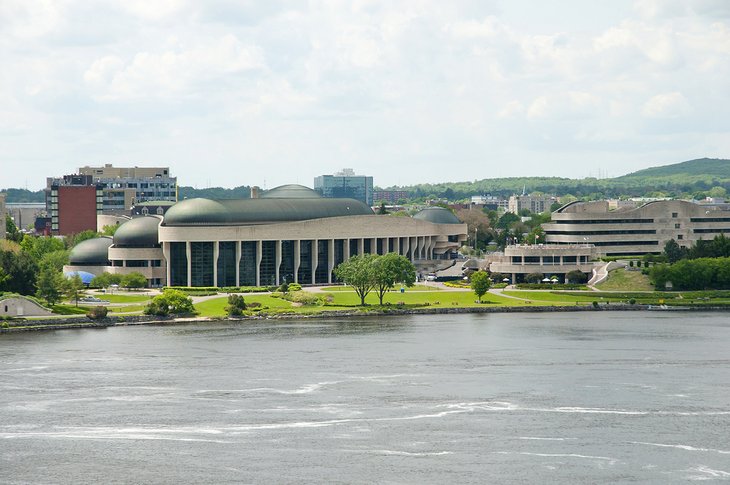
Located in Gatineau, this modern building looks across the river to the Parliament Buildings in Ottawa. The flagship Canadian museum explores human history in Canada, ranging from First Nations cultures in the Pacific Northwest to Norse seafarers. In addition to permanent exhibits, the museum hosts traveling exhibits from partner museums.
Families don't need to worry about the younger ones getting bored - admission to the history museum also includes access to the Canadian Children's Museum, an interactive play-driven place where kids can get hands-on and experience a range of cultures and historic themes. There is also a seven-story IMAX theater at the museum showing a variety of films that look at Canadian history and life in the north.
Address: 100 Laurier Street, Gatineau, Québec
Official site: www.historymuseum.ca
Notre-Dame Basilica
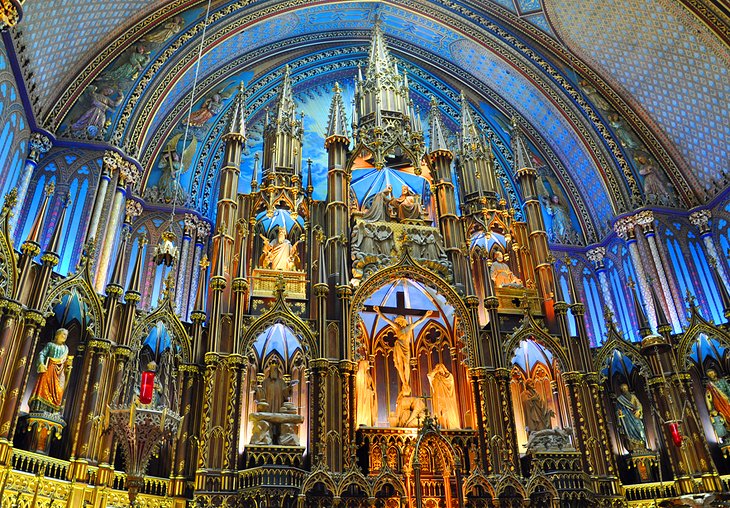
The regal-looking Notre-Dame Basilica is one of the most visited tourist attractions in Old Montréal and the city's oldest church. Its twin towers and neo-Gothic façade stand above Place d'Armes, and the interior was designed by Victor Bourgeau. The church was founded in 1656, and the impressive present-day structure was built in 1829. Inside, the stained-glass windows and ornate wood carvings are a majestic sight.
Other notable features are a 7,000-pipe organ and a hand-carved pulpit; tours are available with an admission charge. Often, an evening light-and-sound show introduces Montréal history through illuminating projections.
In Québec City, there is also the Cathedrale Notre-Dame-de-Quebec, known for its stained-glass windows, Episcopal canopy, and ornate altar. Completed in 1844, it was designed by the architect Baillairgé.
Address: 110 Rue Notre-Dame Ouest, Montréal, Québec
Official site: www.basiliquenotredame.ca
La Citadel de Québec
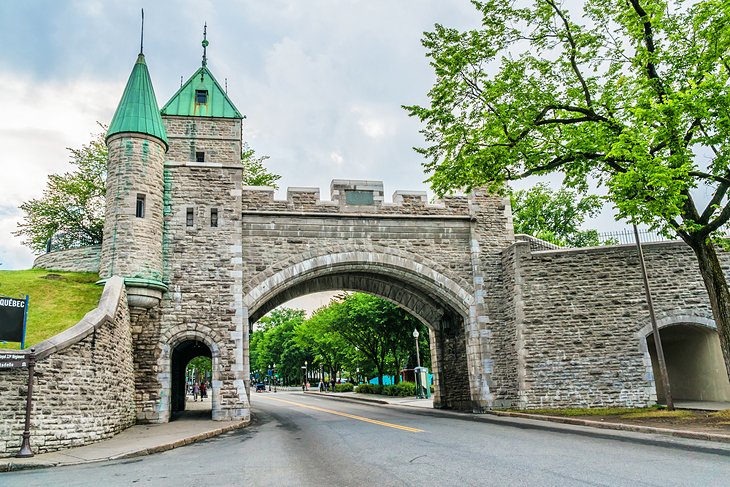
Sitting atop Cap Diamant and facing the St. Lawrence River, the star-shaped Citadel de Québec has been ready to defend Québec City since 1832. Its imposing presence is punctuated by thick walls and commanding ramparts, which are surrounded by deep ditches. The military museum is open year-round and housed in the fort's former 18th-century powder magazine, and during the summer months, tourists are treated to a daily morning Changing of the Guard ceremony.
The Citadel is still in use as an active military post and serves as quarters for all ranks, as well as the summer home of Canada's Governor General. It also serves as the headquarters of the distinguished 22nd Canadian Regiment.
Address: 1 Côte de la Citadelle,Québec City, Québec
Official site: www.lacitadelle.qc.ca/en
Mont Tremblant
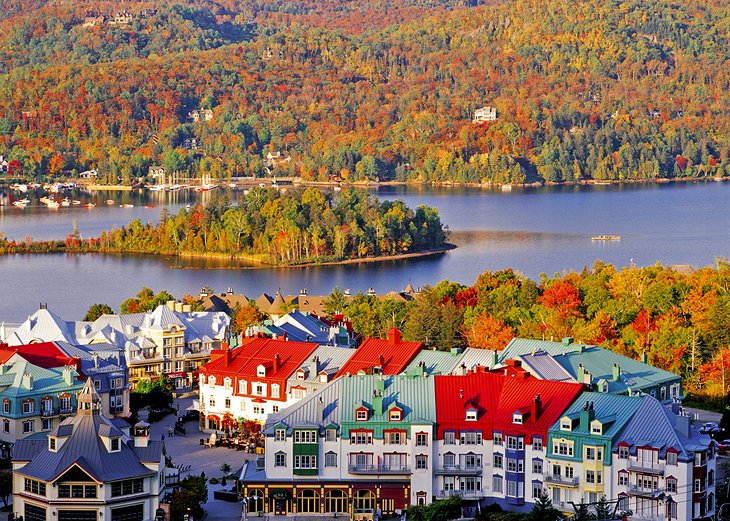
Mont Tremblant is a year-round destination, but it's most commonly known for skiing. Ski resorts in the Canadian Laurentians are favorite winter destinations, and chief among them is Mont Tremblant - one of the highest peaks in the Laurentians (960 meters).
This popular destination is located about 150 kilometers north of Montréal and about 370 kilometers from Québec City. As the premier ski destination in Quebec, Tremblant has a quaint pedestrian village with good restaurants, ample accommodations, and plenty to entertain visitors off the slopes.
In summer, Tremblant offers hiking and biking, canoeing, kayaking, and boat tours, an observation tower, and much more for everything from a couples' getaway to a family vacation. The region is also a fall destination, when leaves turn autumn shades of orange, red, and gold.
Another popular ski area is Mont Sainte-Anne, located near Québec City. In addition to excellent winter sports conditions, the resort offers plenty of summer activities, including camping, hiking, mountain biking, and golf.
Address: 1000 Chemin des Voyageurs Mont-Tremblant, Mont Tremblant, Québec
Parc National d'Opémican
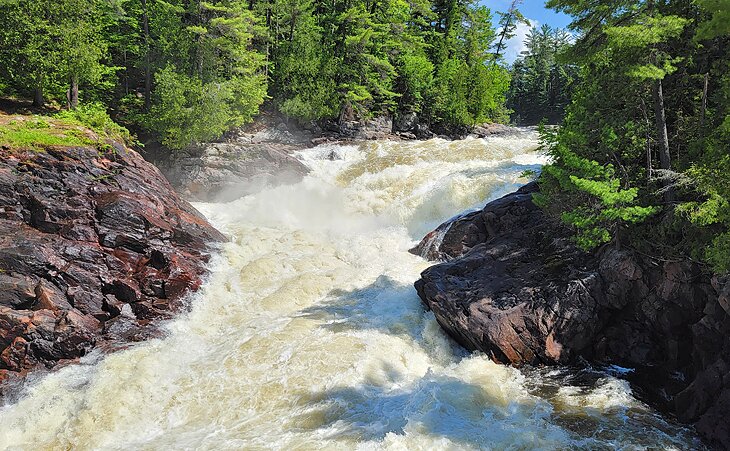
One of Quebec's newest national parks, Parc National d'Opémican, is a fantastic outdoor area that opened to the public in 2018. Located near the Ontario border, it's far from major cities and is a great place to escape crowds and experience some remote wilderness.
The park is divided into four sectors: Pointe-Opémican, Rivière-Kipawa, Île-aux-Fraises, and Lac-White. Each of these offers something a little different, but overall, the park is a blend of natural beauty and historical significance as it relates to the logging history. You can enjoy camping, hiking, canoeing, and kayaking.
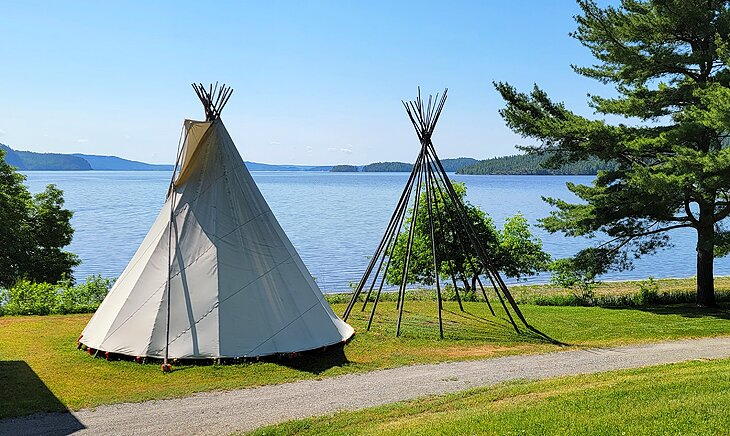
If you are driving through the area and just want to see a beautiful sight, take a walk out to Grande Chute (1.2 kilometers return) in the Rivière-Kipawa sector. Also in the vicinity, just a 45-minute drive from here, is Obadjiwan-Fort Témiscamingue National Historic Site. Costumed interpreters bring this fort from the late 1600s back to life each summer.
Montreal Botanical Gardens (Jardin Botanique)
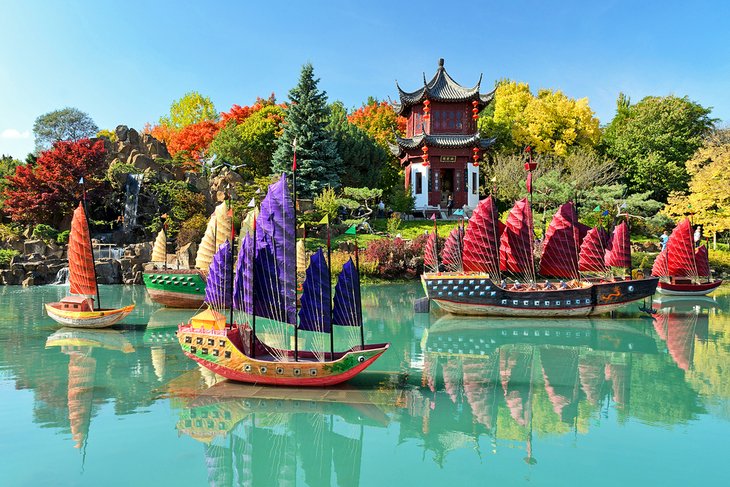
The lush and lovely Botanical Gardens cover 75 hectares adjacent to the Olympic stadium in Montréal's Parc Maisonneuve. The facility is home to both outdoor and greenhouse gardens, many of which are centered around a particular culture. Among the 20 outdoor gardens are the Chinese Garden, Japanese Garden, and First Nations Garden, each of which celebrates the traditions of its respective culture.
The 10 exhibition greenhouses contain a total of around 3,000 specimens, including collections of orchids, bonsai and penjing, cacti, cycads, and many others. The organization also provides talks, workshops, and other educational materials to help visitors with their own gardening endeavors.
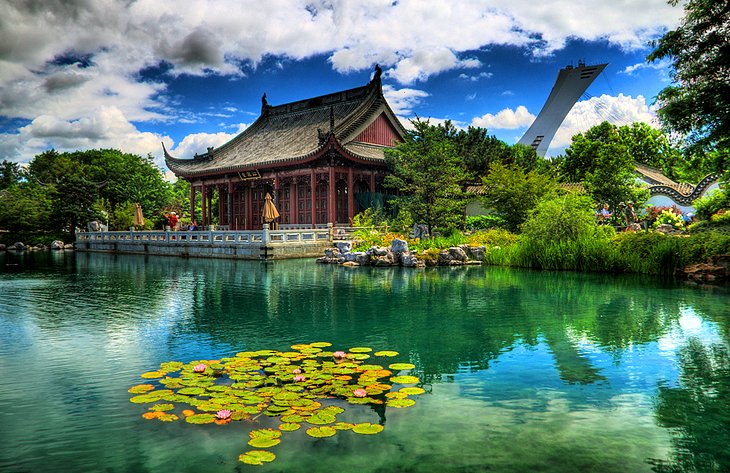
Also within the same park, the Insectarium is a family-friendly attraction that introduces rare and common insects, and there is an excellent planetarium, which immerses visitors in the world of astronomy.
Address: 4101 Rue Sherbrooke Est, Montréal, Québec
Official site: http://espacepourlavie.ca/en/botanical-garden
Zoo de Granby
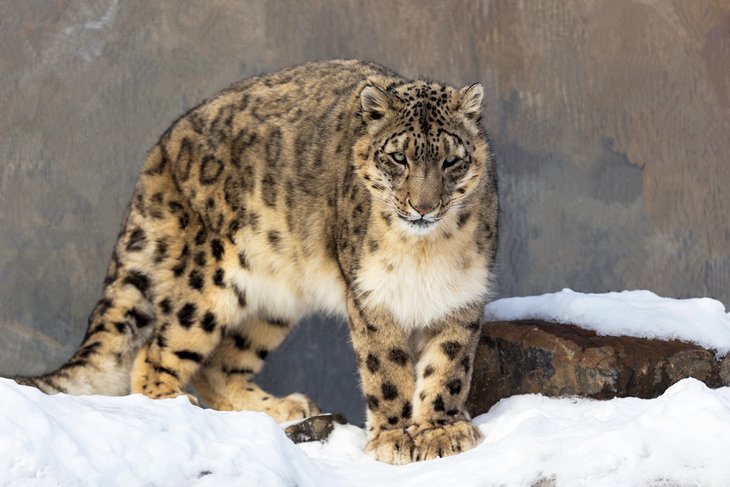
Despite its location in a northern climate, the Zoo de Granby provides comfortable habitats for animals from a wide variety of ecosystems and climates. It is home to more than 225 different species, a total of around 1,500 animals, representing the fauna of Asia, Africa, Oceania, and South America.
This is one of the few zoos that is home to snow leopards, an endangered big cat that is known as "the ghost of the mountains" for its ability to blend in with a snow-covered landscape. The zoo is also home to several other species of big cat, including the Amur leopard, Amur tiger, jaguar, and African lion.
Among other visitor favorites are Oceania's Eastern grey kangaroos, wallabies, and emus, and large animals like Africa's white rhinoceroses, hippopotamuses, giraffes, and elephants. South American residents include alpacas, llamas, and Caribbean flamingos, and Asian animals include the clever red panda, yak, and Bactrian camel.
The zoo also has several primates in residence, including the Western lowland gorilla and Guereza from Africa and the Japanese macaque from Asia. There is also a selection of aquatic animals, including blacktip reef sharks, cownose rays, green sea turtles, and moon jellyfish.
Zoo programs include special presentations by naturalists and other opportunities to learn more about the animals. The zoo is open year-round and is located in the Eastern townships, making it an excellent day trip from Montreal.
During the warmer months, visitors can also enjoy the on-site amusement park at no extra charge. Family-friendly rides include bumper cars, a Ferris wheel, a carousel, and a roller coaster. This portion of the zoo is closed in winter.
Address: 1050 David-Bouchard Blvd., Granby, Quebec
Official site: www.zoodegranby.com/en
Gatineau Park
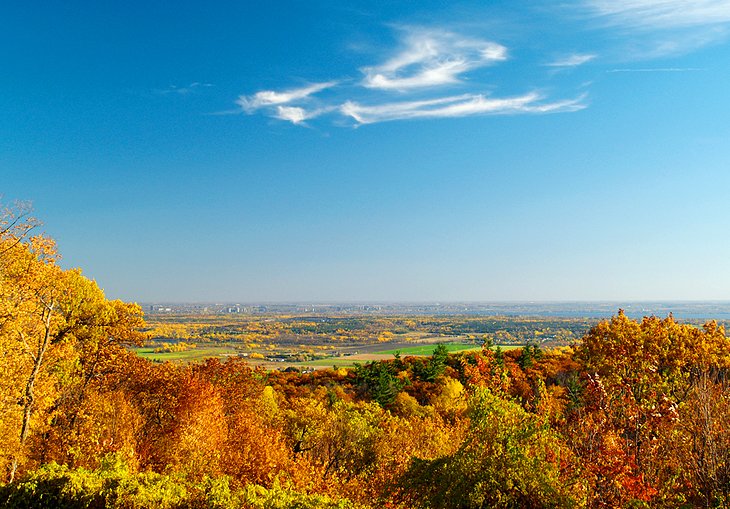
A hilly, largely undeveloped forest and serene lakes make up Gatineau Park, located near the city and river of the same name. Within park boundaries, Mackenzie King Estate is the former home to the eccentric Canadian prime minister William Lyon Mackenzie King, and at Lusk Cave, visitors can take tours of this marble cavern.
Belvédère Champlain (Champlain Lookout) is the park's most popular vantage point, providing photo-worthy views over the river valley and tree-covered hills - an especially impressive sight in autumn. A mix of walkers, cyclists, and dog owners enjoy the park trails, and there are also facilities for camping, swimming, fishing, and skiing.
Address: 33 Scott Road, Old Chelsea, Québec
Official site: https://ncc-ccn.gc.ca/places/gatineau-park
Hudson Bay
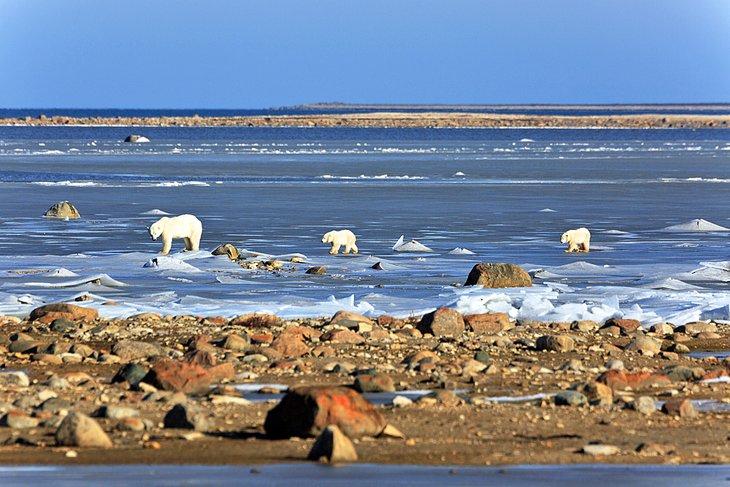
The far-reaching landscape and waters of Hudson Bay are one of the most remote areas of Canada, covering an area of 637,000 square kilometers. With areas reaching into the Arctic Circle, the harsh terrain is home to rarities of the natural world. Here, you can find over 800 species of Arctic vegetation, including Arctic lupine, polar poppies, and purple saxifrage. Migratory birds and seals are common, and polar bears sometimes make an appearance.
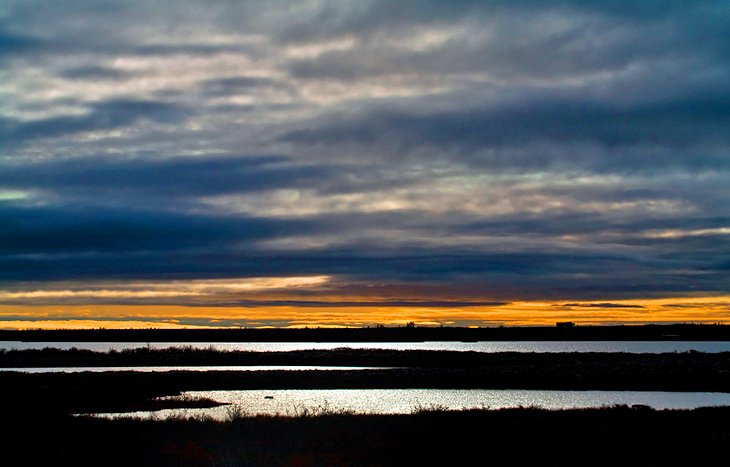
The bay itself is home to a healthy fish population, and Beluga whales are seen occasionally. The Inuit peoples are the traditional residents of the region, and the small outpost communities have stood the test of time.
Read More: Exploring Hudson Bay: A Visitor's Guide
Forillon National Park
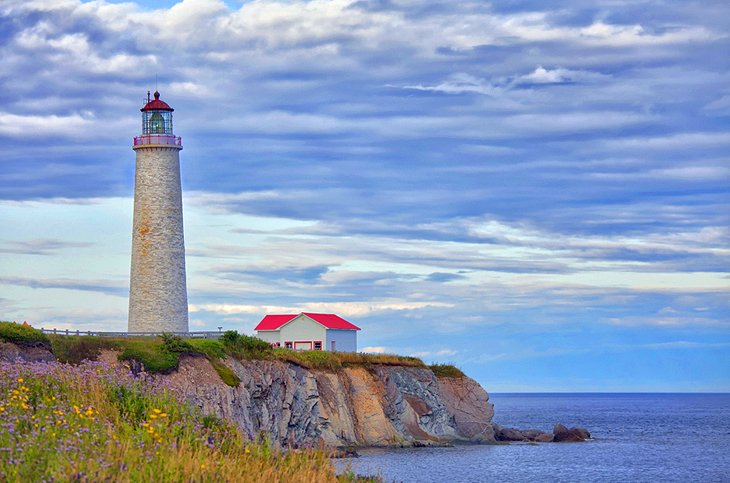
This wild and rugged national park sits at the tip of the Gaspé Peninsula, jutting into the Gulf of St. Lawrence. Dramatic scenery abounds, with limestone cliffs and the isolated Cap des Rosiers Lighthouse. This lighthouse is the tallest in Canada and is also home to a good information center, which provides education about the area's wildlife. This area of Gaspésie is popular with bird-watchers, and you can find several whale-watching boat excursions here. Those who are willing to take the path along Cap Bon-Ami are rewarded with stunning views of the cliffs along the cape.
Address: 122 Gaspé Boulevard, Gaspé, Québec
Official site: www.pc.gc.ca/en/pn-np/qc/forillon
Basilica of Sainte-Anne-de-Beaupré
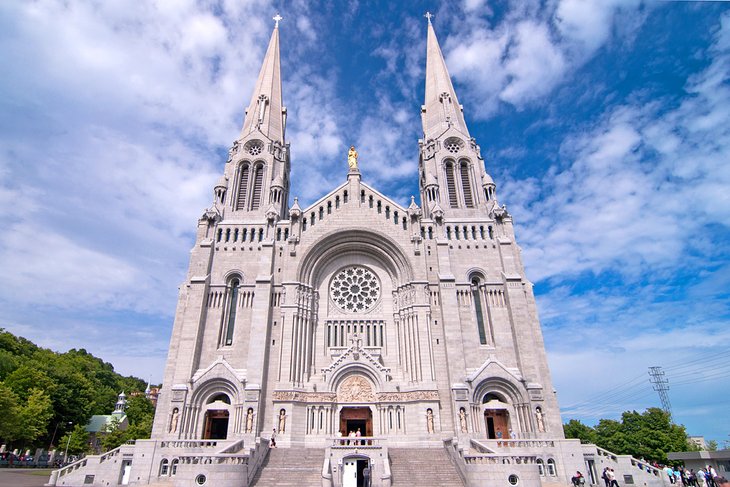
Half a million pilgrims come to the quiet, riverside town of Ste-Anne de Beaupré each year, the home of the Basilica of Sainte-Anne-de-Beaupré. Saint Anne is the patron saint of Québec, and she is credited with many miraculous events. The entryway is covered in discarded crutches, which pay testament to the sick, disabled, and injured people who have reported miracle cures. The existing structure was built in 1926, however, the spot has been home to a house of worship dedicated to Saint Anne since the 17th century.
Also in the area, located just northeast of Québec City, there are river canyons and waterfalls at Chutes Ste-Anne and Sept-Chutes. Here, tourists can explore the nature trails and admire the gorge from suspension bridges.
Address: 10018 Ave Royale, Sainte-Anne-de-Beaupré, Québec
Iles de la Madeleine
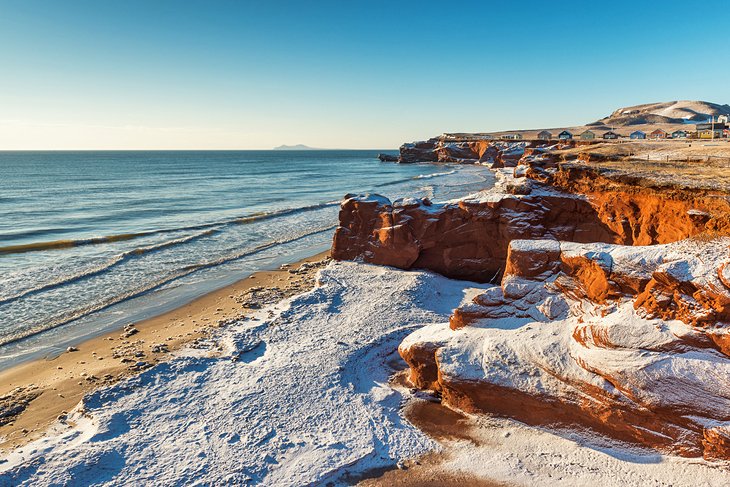
In the Gulf of St. Lawrence, the sand dunes and beaches of the Îles de la Madeleine archipelago are an idyllic and lively spot in summertime. About 90 kilometers of thread-like sand dunes connect six of the twelve islands in the Îles de la Madeleine archipelago. The islands are ideal for water sports, bird-watchers, and anyone who enjoys long walks in the dunes; the best time for a visit is in August.
Île du Havre aux Maisons, with its gentle hills, red cliffs, winding paths, and scattered houses, is one of Îles de la Madeleine's most beautiful islands. Traditional homes stand between a heritage school,a century-old convent, and Sainte-Madeleine Church. Also on Havre-aux-Maisons, Cap Alright has a small lighthouse and is noted for its impressive offshore rock formations.
Half the people of the archipelago live on Île du Cap aux Meules, and from here, a ferry crosses to Île d'Entrée, the only inhabited island not connected to the others. There is a wonderful view from the Butte du Vent over the surrounding islands, and on a clear day it is possible to see as far as Cape Breton Island, nearly 100 kilometers away. Île du Havre-Aubert is the southernmost island in the archipelago, and its little town has the Musée de la Mer.
Bonaventure Island (île Bonaventure)
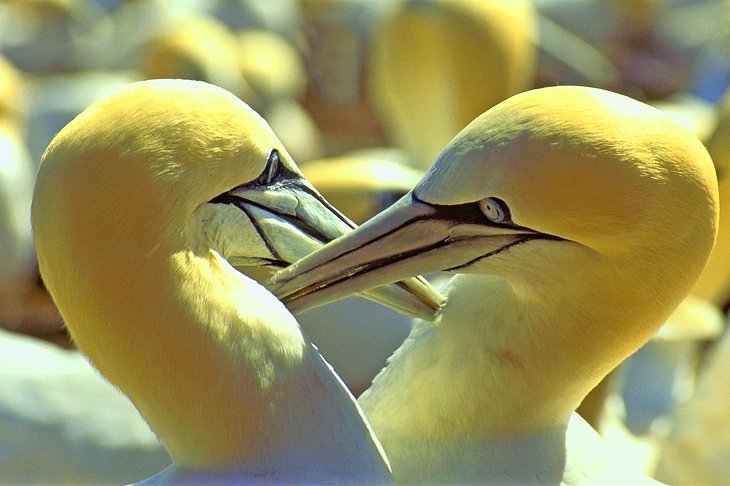
This island off the Gaspé Peninsula in the Gulf of St. Lawrence is a renowned bird sanctuary, where about 50,000 gannets flock during the summer. The island features the Gaspésie's rugged, picturesque scenery and sheer rocky cliffs. A nature trail provides a bird-watching route, where tourists will also see other seabirds, including Atlantic puffins, terns, razorbills, and multiple varieties of cormorants.
The park also encompasses the much-photographed Rocher Percé (Pierced Rock) among other rocky outcrops and magnificent cliffs, which have been carved by the elements. The island's position along the Percé Coast makes it an excellent destination for photographers and nature lovers during the summer months.
Official site: http://www.sepaq.com/pq/bon/
Mount Royal Park
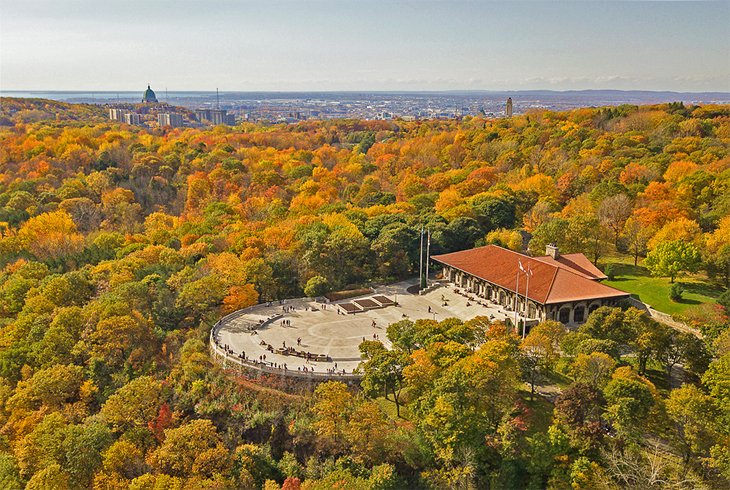
Mont Royal is not only Montréal's namesake but also the mountain at its heart. The 233-meter peak allows for a fine vantage over the largest city in Québec, especially from the Kondiaronk Belvedere.
There are many events in the park, from winter ice-skating on Lac-aux-Castors and cross-country skiing to the beat of many drums at Les Tam-Tams, which happens on summer Sundays near the Sir George-Étienne Cartier monument. From the platform on the summit, visitors have a panoramic view over the Île de Montréal and the St. Lawrence River. If the air is particularly clear, you can also see the peaks of the Adirondacks in the U.S.
Official site: www.lemontroyal.qc.ca/en


